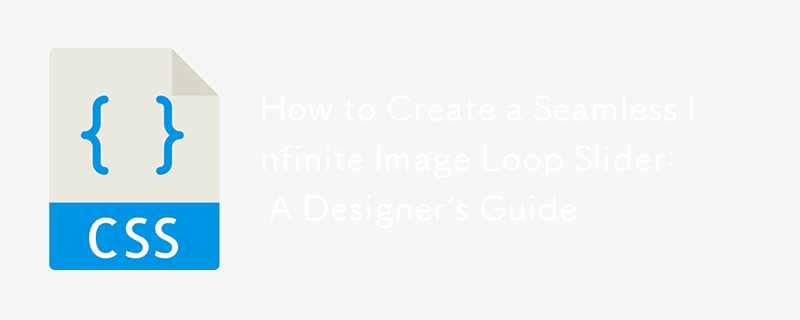 Web Front-end
Web Front-end
 CSS Tutorial
CSS Tutorial
 How to Create a Seamless Infinite Image Loop Slider: A Designer's Guide
How to Create a Seamless Infinite Image Loop Slider: A Designer's Guide
How to Create a Seamless Infinite Image Loop Slider: A Designer's Guide

Infinite Loop Image Slider Design Concepts
Introduction:
Building an infinite image loop slider can be a complex task, but understanding the underlying concepts can simplify the process. Here are some best practices and design blueprints to guide you:
Clone First and Last Images:
This concept involves duplicating the first and last images in the image sequence. The copied image is placed before the first image and after the last image. This creates the illusion of an endless loop by transitioning smoothly from the last image to the first (or vice versa).
DOM Structure:
The DOM structure is crucial for implementing an infinite loop slider. The images should be structured in a single row with inline-block display and no whitespace, ensuring they align seamlessly.
Container Positioning:
The container holding the images is typically positioned using left, margin-left, or transform (translateX) properties. Initially, the container is positioned to display the first image.
Looping Logic:
The infinite loop is achieved through JavaScript or jQuery animations. When transitioning from the last image to the first, the container position is instantly adjusted to display the first image. Similarly, when moving from the first to the last image, the container is repositioned to display the last image.
Clone Offset:
The cloned images are placed with offsets to ensure smooth transitions. For example, if the images are 100px wide, the cloned first image would be offset by -100px and the cloned last image by 100px from their original positions.
Animation and Event Handling:
Clicking navigation buttons initiates JavaScript animations that adjust the container's position. Animation completion triggers callback functions that handle the loop transition by repositioning the container to the correct offset.
Example Implementation:
A simple example using jQuery and CSS can be found here: http://jsbin.com/ufoceq/8/
Conclusion:
This blueprint provides a solid foundation for building an infinite image loop slider with good code readability, reusability, and performance. By implementing these concepts, you can create a seamless and visually appealing user experience.
The above is the detailed content of How to Create a Seamless Infinite Image Loop Slider: A Designer's Guide. For more information, please follow other related articles on the PHP Chinese website!

Hot AI Tools

Undresser.AI Undress
AI-powered app for creating realistic nude photos

AI Clothes Remover
Online AI tool for removing clothes from photos.

Undress AI Tool
Undress images for free

Clothoff.io
AI clothes remover

AI Hentai Generator
Generate AI Hentai for free.

Hot Article

Hot Tools

Notepad++7.3.1
Easy-to-use and free code editor

SublimeText3 Chinese version
Chinese version, very easy to use

Zend Studio 13.0.1
Powerful PHP integrated development environment

Dreamweaver CS6
Visual web development tools

SublimeText3 Mac version
God-level code editing software (SublimeText3)

Hot Topics
 1378
1378
 52
52
 Working With GraphQL Caching
Mar 19, 2025 am 09:36 AM
Working With GraphQL Caching
Mar 19, 2025 am 09:36 AM
If you’ve recently started working with GraphQL, or reviewed its pros and cons, you’ve no doubt heard things like “GraphQL doesn’t support caching” or
 Building an Ethereum app using Redwood.js and Fauna
Mar 28, 2025 am 09:18 AM
Building an Ethereum app using Redwood.js and Fauna
Mar 28, 2025 am 09:18 AM
With the recent climb of Bitcoin’s price over 20k $USD, and to it recently breaking 30k, I thought it’s worth taking a deep dive back into creating Ethereum
 Creating Your Own Bragdoc With Eleventy
Mar 18, 2025 am 11:23 AM
Creating Your Own Bragdoc With Eleventy
Mar 18, 2025 am 11:23 AM
No matter what stage you’re at as a developer, the tasks we complete—whether big or small—make a huge impact in our personal and professional growth.
 Vue 3
Apr 02, 2025 pm 06:32 PM
Vue 3
Apr 02, 2025 pm 06:32 PM
It's out! Congrats to the Vue team for getting it done, I know it was a massive effort and a long time coming. All new docs, as well.
 A bit on ci/cd
Apr 02, 2025 pm 06:21 PM
A bit on ci/cd
Apr 02, 2025 pm 06:21 PM
I'd say "website" fits better than "mobile app" but I like this framing from Max Lynch:
 Can you get valid CSS property values from the browser?
Apr 02, 2025 pm 06:17 PM
Can you get valid CSS property values from the browser?
Apr 02, 2025 pm 06:17 PM
I had someone write in with this very legit question. Lea just blogged about how you can get valid CSS properties themselves from the browser. That's like this.
 Stacked Cards with Sticky Positioning and a Dash of Sass
Apr 03, 2025 am 10:30 AM
Stacked Cards with Sticky Positioning and a Dash of Sass
Apr 03, 2025 am 10:30 AM
The other day, I spotted this particularly lovely bit from Corey Ginnivan’s website where a collection of cards stack on top of one another as you scroll.
 Let's use (X, X, X, X) for talking about specificity
Mar 24, 2025 am 10:37 AM
Let's use (X, X, X, X) for talking about specificity
Mar 24, 2025 am 10:37 AM
I was just chatting with Eric Meyer the other day and I remembered an Eric Meyer story from my formative years. I wrote a blog post about CSS specificity, and



